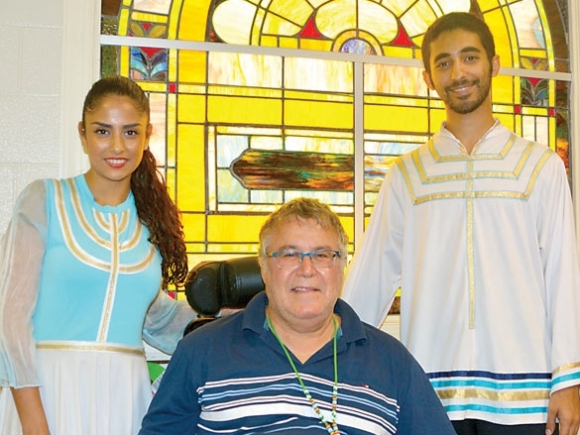‘We want the peace’: Israeli group director preaches harmony through dance

Home to some of the most important and sacred Judeo-Christian sites in the world, what should be a place of peace has instead seen almost ceaseless conflict since its incorporation in 1948.
The nation of Israel is a study in contrasts, and the same goes for the founder of the Israeli dance group Ayalot Ha’Negev – Motti Alkis, a man who went to war to heal and as a result can no longer walk, but still teaches dance.
“I was a medic,” Alkis said – a medic, a healer, in the midst of 1973’s bloody Arab-Israeli war.
That conflict found Israel surprised by an attack — on Yom Kippur, the holiest day of the year — from a coalition consisting of Algeria, Cuba, Egypt, Iraq, Jordan, Morocco, Saudi Arabia and Syria.
Outnumbered almost two-to-one, Israel initially saw startling territorial losses, but rebounded by the end of the 19-day conflict to inflict almost 60,000 casualties on the coalition, while suffering just 10,000 of its own.
Alkis spent his time in the Israeli armed forces helping the sick and wounded, until he became one of them himself.
Related Items
“I maybe drink something not so good,” he said in broken English. “Or maybe it was the blood.”
Alkis unknowingly contracted hepatitis somehow, perhaps by treating a wound or coming into contact with bodily fluids while out in the desert.
A few years later, Alkis — a dancer himself — began to notice he couldn’t execute some of his moves as smoothly as he could previously. It was then he learned that he had muscular dystrophy, possibly as a result of his treatment for the hepatitis he picked up during the war.
At that time, right around 1980, Alkis founded Ayalot Ha’Negev, the Dance Company of the State of Israel. Over the intervening years, the troupe has performed in 65 countries across the world, even as his condition began to deteriorate.
“I teach all that time,” he said. “I fight [the disease] all the time.”
The illness steadily progressed, and for the past three years, Alkis has been confined to a motorized wheelchair, but that hasn’t stopped him from helping the group continue to spread its message of peace through dance.
“It’s is a miracle that he is even here with us today,” said one of Alkis’ dancers, Eden. “He is a very religious person, very strong faith and it is a miracle.”
Lucky to even be alive, the enigmatic Alkis commands his performers with an authoritative style of communication that transcends the physical.
“I walk with my heart, I walk with my spirit,” said Alkis.
“We have a common language,” Eden said. “We understand him even though he can’t show us, it’s like a language how he can teach us.”
The significance of what Alayot Ha’ Negev does isn’t lost on Alkis’ young dancers.
“It’s very important,” said another dancer, Stav. “In this festival we have the opportunity to show people to think different things about us. There are a lot of stereotypes and then we came with very long smiles and very much happiness.”
The travails of the beleaguered Jewish people are well-known and far-reaching, as are the ugly stereotypes associated with them; perhaps the only thing that has kept the world’s Jewish community from utter extinction at the hands of its enemies throughout the centuries is its cohesiveness.
“In their dance, they try to show togetherness,” said Izzy Hendershot, one of the group’s local guides. “Even their costumes are very light and happy.”
One need only witness a small part of Alayot Ha’ Negev’s performance to see joyous dancers join hands in one big circle, undulating to and fro with lively shouts and arms raised in celebration to the sky.
“We bring the peace, we want to bring the peace,” Eden said. “Our religion is searching for peace. We don’t want fights.”
“Peace,” said Alkis. “Only peace.”









